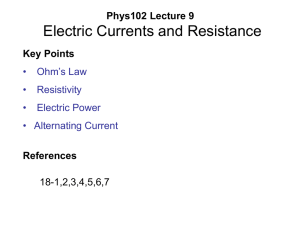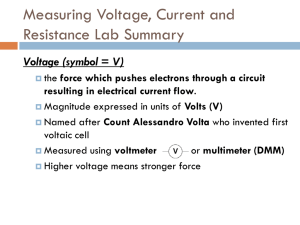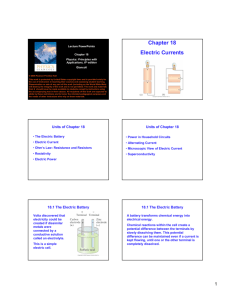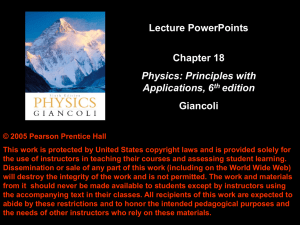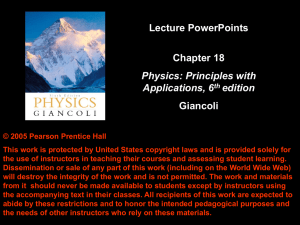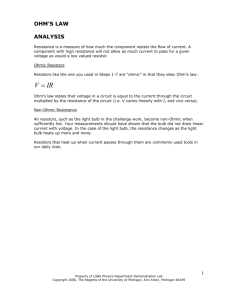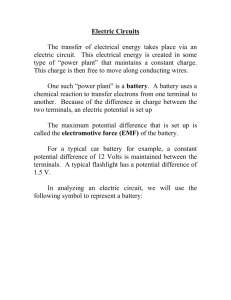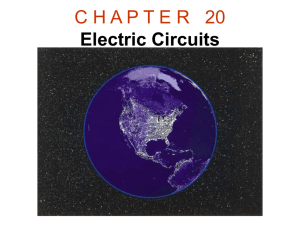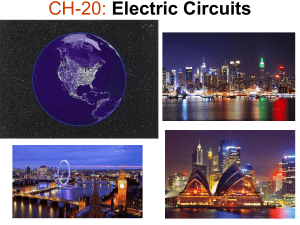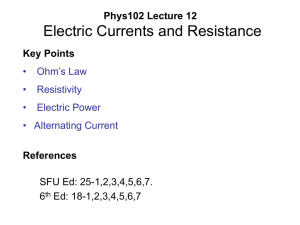Chapter 18 Electric Currents Higher maximum
advertisement
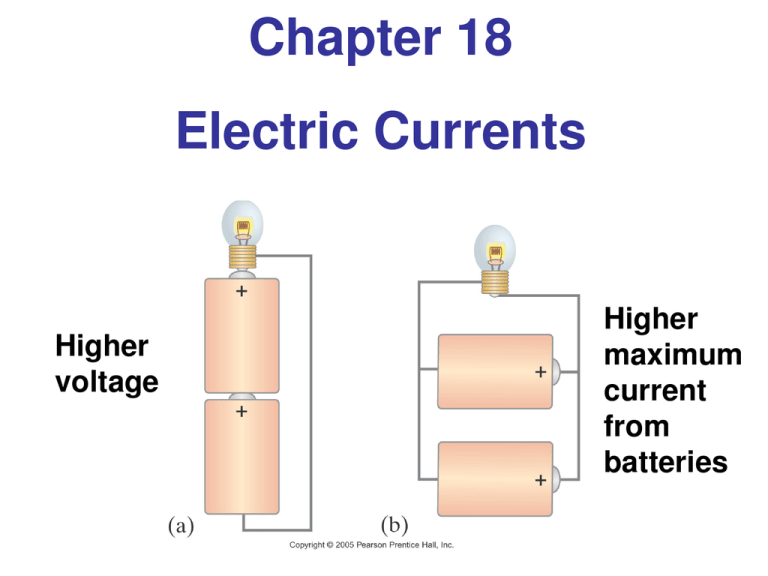
Chapter 18 Electric Currents Higher maximum current from batteries Higher voltage Chapter 18 • Electric Current • Ohm’s Law: Resistance and Resistors • Resistivity of a material • Electric Power • Power in Household Circuits • Alternating Current • Microscopic View of Electric Current Electric Current Electric current is the rate of flow of charge through a conductor: This is more specifically the charge that moves past any point per unit time. Unit of electric current: the ampere, A. 1 A = 1 C/s Electric Current By convention, current is defined as flowing from + to ­ . Electrons actually flow in the opposite direction, but not all currents consist of electrons. Resistance and Resistors The ratio of voltage to current is called the resistance: Ohm’s Law: Unit of resistance: the ohm, Ω. 1 Ω = 1 V/A Ohm’s Law: Resistance and Resistors In many conductors, the resistance is independent of the voltage; this relationship is called Ohm’s law. Materials that do not follow Ohm’s law are called nonohmic: b) is for a diode Ohm’s Law: Resistance and Resistors Some clarifications: • Batteries maintain a (nearly) constant potential difference; current varies depending on the ‘load’. • Resistance is a property of a material or device. • Current is not a vector but it does have a direction ­ from positive toward negative potential • Current and charge do not get used up. Whatever charge goes in one end of a circuit comes out the other end. Resistivity The resistance of a wire is directly proportional to its length and inversely proportional to its cross­sectional area: The constant ρ, called the resistivity, is characteristic of the material. This equation is specific to a geometry having a constant cross sectional area (like a cylinder) with current flowing along the length Resistivity of Specific Materials Resistivity: Temperature Dependence For metals, resistivity increases with temperature: This is also true for most insulators; however, Semiconductors are complex materials, and often have resistivities that decrease with T . Electric Power Power, as in kinematics, is the energy transformed by a device per unit time: Electric Power (DC) The unit of power is the watt, W. For ohmic devices, we can make the substitutions: Alternating Current Current from a battery flows steadily in one direction (direct current, DC). Current from a power plant varies sinusoidally (alternating current, AC). Alternating Current The voltage varies sinusoidally with time: as does the current: (18­7) Alternating Current Multiplying current and voltage gives the power: Average power Alternating Current Usually we are interested in the average power: Alternating Current The current and voltage both have average values of zero, so we square them, take the average, then take the square root. This is called the root mean square (rms) value. For AC Pave = I rms Vrms Microscopic View of Electric Current Electrons in a conductor have large, random speeds just due to temperature. When a potential difference is applied, the electrons also acquire an average drift velocity, which is generally considerably smaller than the thermal velocity. Microscopic View of Electric Current This drift speed is related to the current in the wire, and also to the number of electrons per unit volume. So Or “current density” I /A = nevd Summary of Chapter 18 • Electric current is the rate of flow of electric charge. • Conventional current is in the direction that positive charge would flow. • Resistance is the ratio of voltage to current: • Ohmic materials have constant resistance, independent of voltage. Summary of Chapter 18 • Resistance is determined by shape and material: • ρ is the resistivity, and is a material property. • Power in an electric circuit: • Direct current is constant • Relation between drift speed and current: Summary of Chapter 18 • Alternating current varies sinusoidally • The average (rms) current and voltage:
